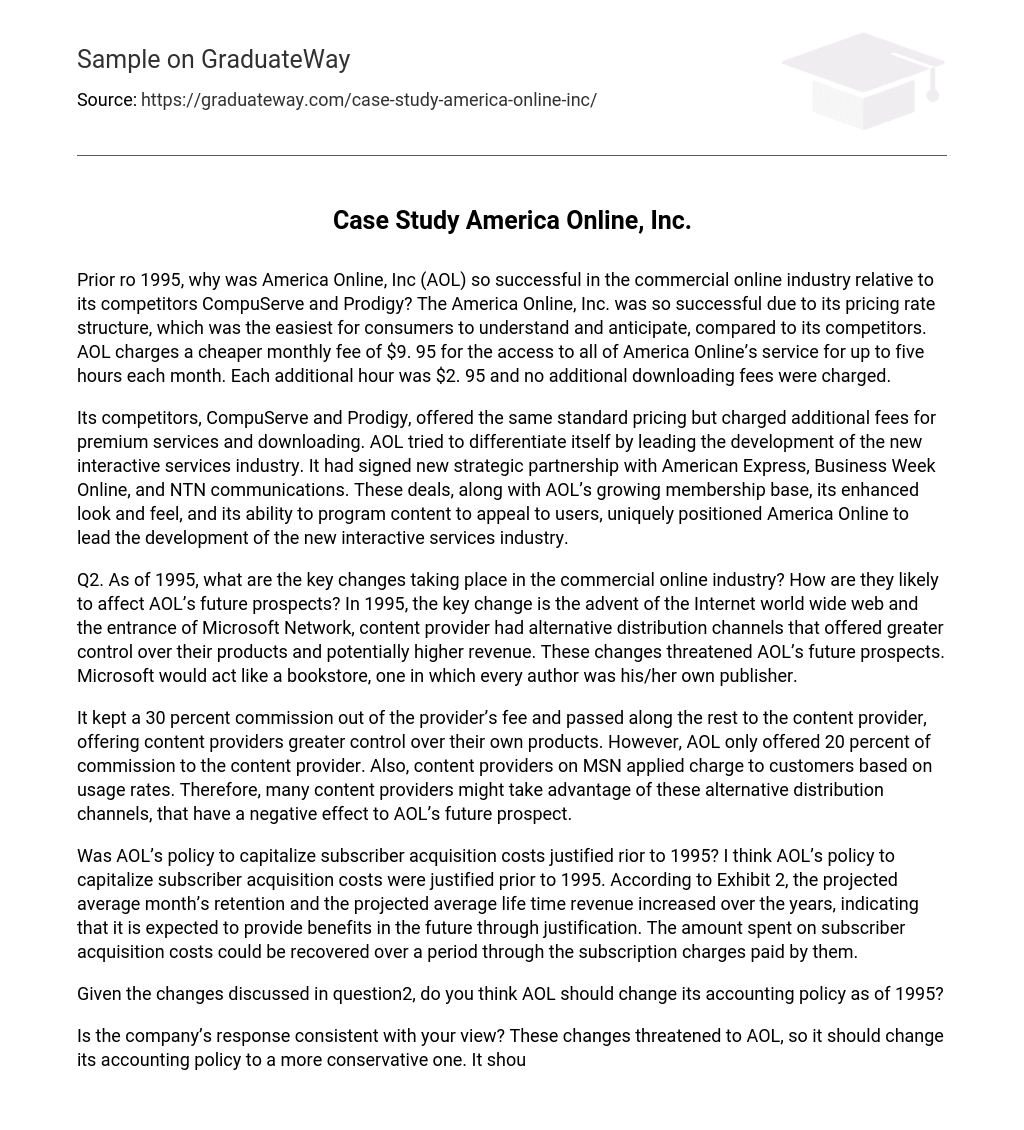Prior ro 1995, why was America Online, Inc (AOL) so successful in the commercial online industry relative to its competitors CompuServe and Prodigy? The America Online, Inc. was so successful due to its pricing rate structure, which was the easiest for consumers to understand and anticipate, compared to its competitors. AOL charges a cheaper monthly fee of $9. 95 for the access to all of America Online’s service for up to five hours each month. Each additional hour was $2. 95 and no additional downloading fees were charged.
Its competitors, CompuServe and Prodigy, offered the same standard pricing but charged additional fees for premium services and downloading. AOL tried to differentiate itself by leading the development of the new interactive services industry. It had signed new strategic partnership with American Express, Business Week Online, and NTN communications. These deals, along with AOL’s growing membership base, its enhanced look and feel, and its ability to program content to appeal to users, uniquely positioned America Online to lead the development of the new interactive services industry.
Q2. As of 1995, what are the key changes taking place in the commercial online industry? How are they likely to affect AOL’s future prospects? In 1995, the key change is the advent of the Internet world wide web and the entrance of Microsoft Network, content provider had alternative distribution channels that offered greater control over their products and potentially higher revenue. These changes threatened AOL’s future prospects. Microsoft would act like a bookstore, one in which every author was his/her own publisher.
It kept a 30 percent commission out of the provider’s fee and passed along the rest to the content provider, offering content providers greater control over their own products. However, AOL only offered 20 percent of commission to the content provider. Also, content providers on MSN applied charge to customers based on usage rates. Therefore, many content providers might take advantage of these alternative distribution channels, that have a negative effect to AOL’s future prospect.
Was AOL’s policy to capitalize subscriber acquisition costs justified rior to 1995? I think AOL’s policy to capitalize subscriber acquisition costs were justified prior to 1995. According to Exhibit 2, the projected average month’s retention and the projected average life time revenue increased over the years, indicating that it is expected to provide benefits in the future through justification. The amount spent on subscriber acquisition costs could be recovered over a period through the subscription charges paid by them.
Given the changes discussed in question2, do you think AOL should change its accounting policy as of 1995?
Is the company’s response consistent with your view? These changes threatened to AOL, so it should change its accounting policy to a more conservative one. It should reduce the amortization for subscriber’s acquisition costs and expense certain amounts of these costs. But AOL’s response was inconsistent with my opinion and it decided to extend the period over which these costs were amortized from 18 to 24 months. This amortization decreased the reported loss significantly by $1. 95 million for the three months ended September 30, 1995.
It made AOL to run the risk of not recovering those expenditures in the future. Also, AOL’s action might potentially distort the reported profit and performance of the company, which increased its financial risk of financial statement.
What would be the effect on AOL’s 1994 and 1995 ending balance sheets if the company had followed the policy of expensing subscriber acquisition outlays instead of capitalizing them? What would be the effect of expensing subscriber acquisition costs on AOL’s 1995 income statement?
By expensing subscriber acquisition outlays instead of capitalizing them, the expense increased in the income statement and the total asset decreased from the balance sheet. The shareholder’s equity will also be reduced. In this case, AOL’s total asset will be written off and owners’ equity and deferred taxes would define by the same amount as well in the balance sheet. For the income statement, under an immediate expensing policy, the expenses would go up, resulting in a reduction in operating income by the same amount as well.





